Cost Effective Options for Greenhouse Gas (GHG) Emission Reduction in the Power Sector for Developing Economies — A Case Study in Sabah, Malaysia
Abstract
:1. Introduction
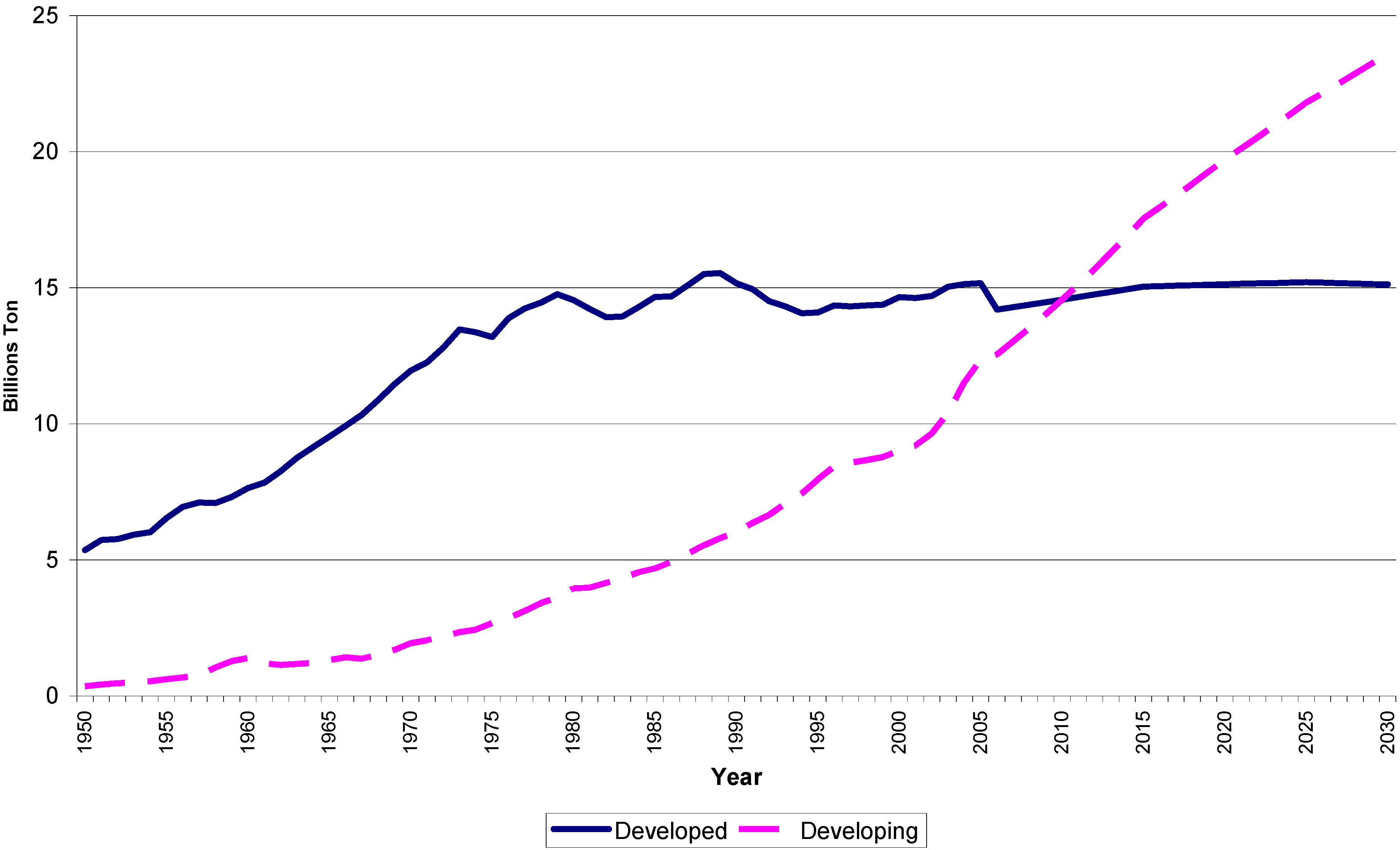
- Limited Technical Expertise: In the global expenditure on research and development (R & D) on sustainable energy in 2009 [7], USD 18.9 billion or 77% are from the US and Europe. In terms of expertise and technological capabilities, the developing countries still lag far behind the developed countries. Therefore, during the attempts to adopt the state of the arts technologies touted by the developed world, the developing countries are having difficulties to recruit sufficient expertise to ensure the successful implementation and operations of these technologies.
- Increasing Electricity Demand: Industrialisation is still a main transformation factor in the GDP growth of many developing nations. The electricity demand typically grows in tandem with the GDP. It is important to implement power generation technologies with low cost and high scalability to fuel the GDP growth. In Sabah, one of the 13 states in Malaysia, for example, the power plant capacity is to increase from about 1 GW in 2010, to above 5 GW by 2030.
- Financial Constraint: Per capita income in the developing countries is lower than that of the developed countries. In Malaysia, for example, the current per capita income is 7,600 USD compared to that of developed countries of more than 15,000 USD. Therefore, consumers in the developing countries cannot afford a significant increase in electricity price to cover the costs of green technology. The established technologies such as photovoltaic panels, with a generation cost more than six times that of the conventional technology are simply not affordable,.
- Fuel Mix: Malaysia, like other developing countries, is dependent heavily on fossil fuels, which account for more than 90% of its electricity generation [8]. Coal alone supply more than a quarter of the country’s electricity meet and its share is projected to increase as part of the country’s fuel diversification policy to avoid over dependent on natural gas.
- Renewable Resources Availability: The adoption of renewable energy is also dependent upon sufficient local energy resource. The US has the average wind velocity of more than 5 m/s and Europe of more than 7 m/s. However, in Malaysia the wind speed in between 2 to 3 m/s. With a typical cut-in speed of 3 m/s [9], there is little energy to be exploited.
- Need for Scalability of Technologies: The rapid increase in the power demands of the developing countries needs to be met using technologies with high scalability. In the developed countries, where the power demands are relatively constant, green energy sources can be added to merely reduce the usage of their existing power plants with high emission factors. In the developing countries, however, new power plants need to be installed to meet the increasing power demands. The outputs of renewable energy generators are usually intermittent. Their output profiles may not coincide with the demand profiles. As a result, reserved or standby power plants, such as gas power plants, need to be installed, hence causing a further increase in the already high cost of the technologies.
- Renewable energy;
- Supply side energy efficiency;
- Demand side energy efficiency; and
- Transmission, distribution and ancillary technologies.
2. The Power System in Sabah
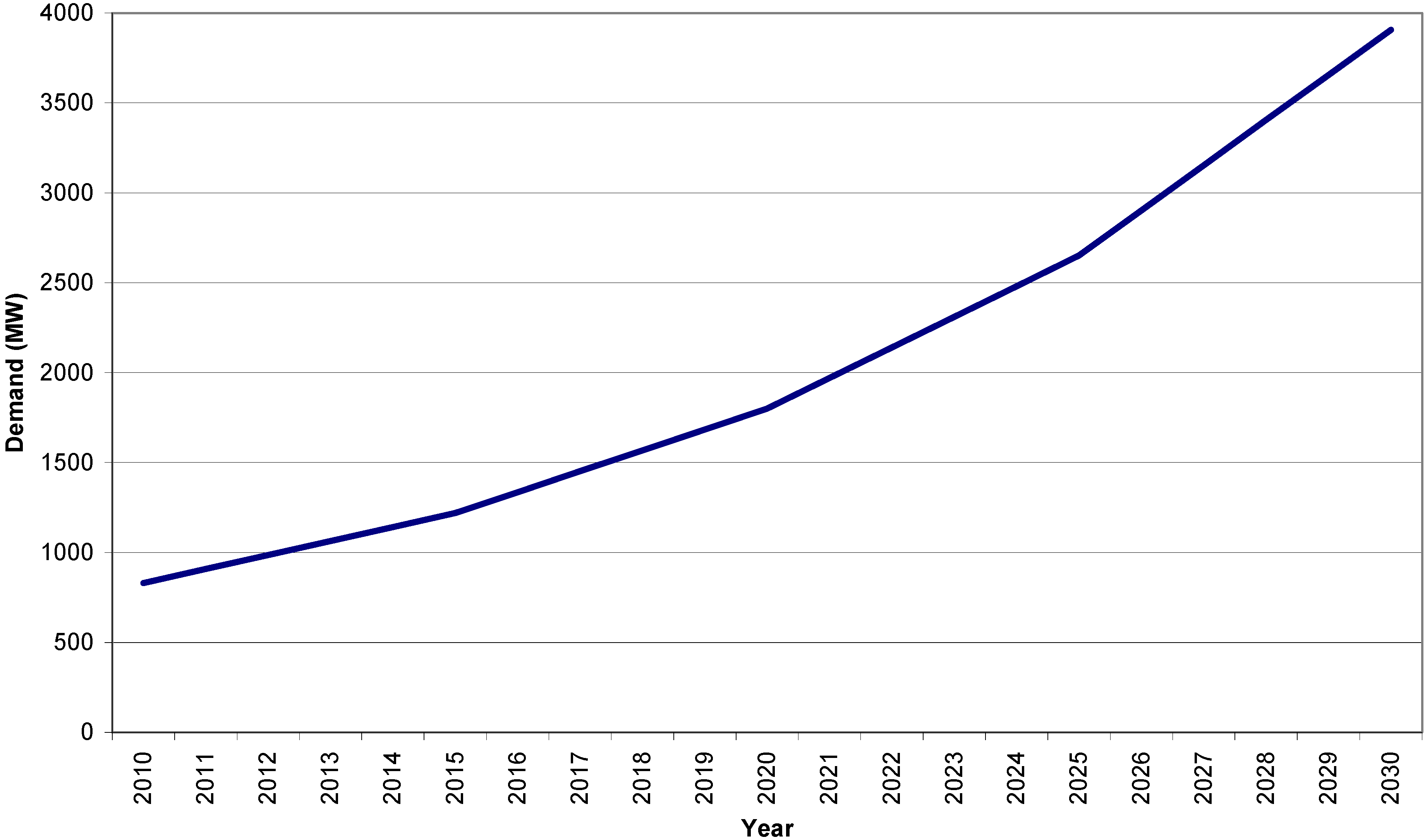
3. Emission Reduction Technologies
3.1. Renewable Energy

3.2. Supply Side Energy Efficiency
3.3. Demand Side Energy Efficiency
- Policy and regulatory: These measures include energy price rationalization, reducing import duties, subsidization, appliance efficiency standards and labeling, and building energy efficiency codes.
- Institutional: These measures include public information programs and training on energy efficiency.
- Financial: These measures include affordable financing and financial incentives for the purchase of energy efficient appliances.
- Enforcing the Efficient Management of Electricity Energy Regulation 2008 to ensure more efficient use of electricity among large users.
- Incorporating the Code of Practice on Energy Efficiency and Use of Renewable Energy for Non-Residential Buildings (MS1525:2007) into the Uniform Building By-Laws (UBBL).
- Promoting the use of highly energy-efficient appliances and equipment.
- Developing local expertise in the manufacture of energy-efficient appliances and equipment.
- Improving energy efficiency in government buildings.
- Developing human capacity in the area of energy efficiency.
3.4. Transmission, Distribution and Ancillary Technologies
4. Methodology
- Constructing the energy model for Sabah;
- Creating GHG emission reduction scenarios;
- Evaluating financial and GHG emission for every scenario; and
- Assessing cost effectiveness in every scenario.
4.1. Sabah Energy Model in LEAP
- Sabah electricity demand projection over the next 20 years from 2010 to 2030.
- The power plant-up plan over the next 20 years.
- Hourly load demand profile.
- Life-span, capital cost and other essential operating and maintaining expenditures for all electricity generation options.
4.2. GHG Emission Reduction Scenarios
| Scenario | Technologies |
|---|---|
| S0 | Business as usual |
| S1 | Solar Photovoltaic cell |
| S2 | Hydropower |
| S3 | Biomass from palm oil waste |
| S4 | Supply side energy efficiency–advanced combustion technology |
| S5 | Carbon capture technology |
| S6 | Demand side energy efficiency–Industrial Sector |
| S7 | Demand side energy efficiency–Building |
| S8 | Energy efficient device–Energy saving bulbs |
| S9 | Energy import from Bakun |
4.3. Financial and GHG Emission Evaluation
| where: | : | Aggregated cost of all electricity generated over the projection period for S0. The cost includes annualised capital cost, variable operation and maintenance (O&M) cost, fixed O&M cost and fuel cost. (RM) |
| : | Generation cost using technology in year for S0. The cost includes annualised capital cost, variable O&M cost, fixed O&M cost and fuel cost. (RM) | |
| : | Index for type of power generation technology in the simulated scenario | |
| : | Index for year in the simulation period | |
| : | Aggregated GHG emissions of all electricity generated over the projection period for S0. (ton CO2 equivalent) | |
| : | GHG emissions using technology in year for S0. (ton CO2 equivalent) | |
| : | Aggregated electricity output over the projection period for S0. (kWh) | |
| : | Electricity output using technology in year for S0. (kWh) |
4.4. Cost Effectiveness Assessment
5. Source Data
5.1. Source Data for Energy Model
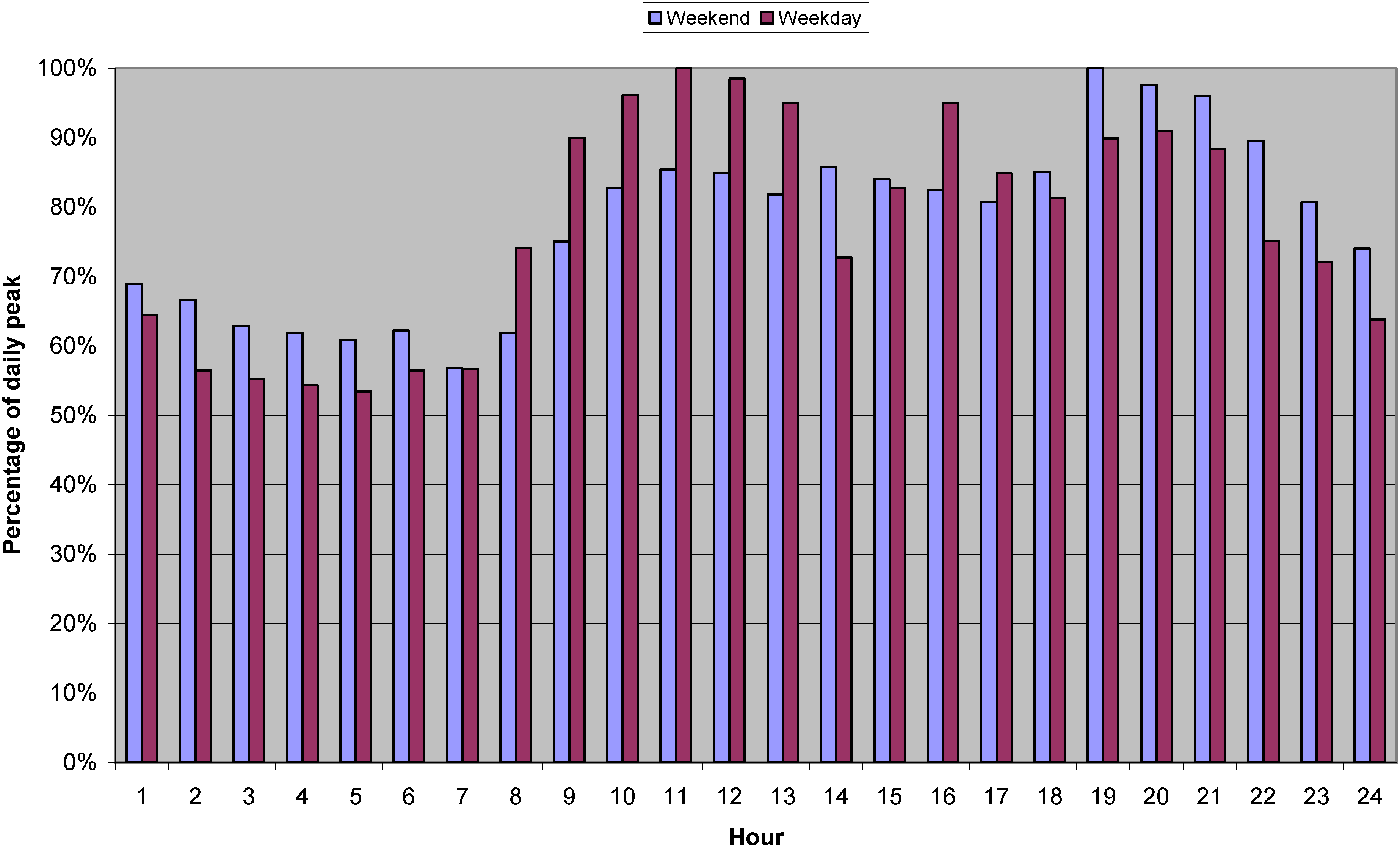
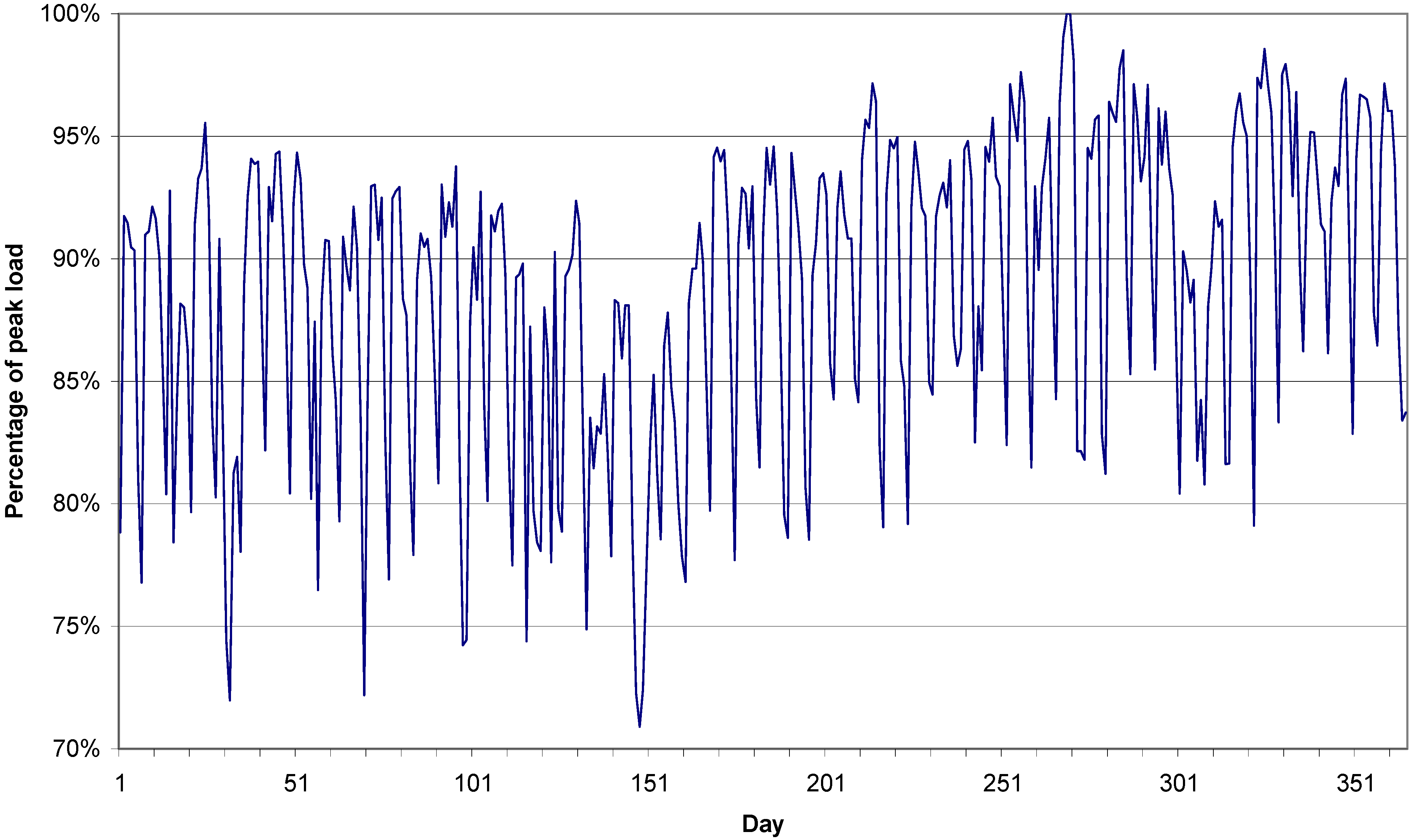

5.2. Source Data for Financial Assessment
| No | Technology (Scenario) | Plant Life Time (Years) | Efficiency (%) | Capital Cost [RM (US$)/kW] | Fuel cost [RM (US$)/kWh output] a | Fixed O&M cost [RM (US$)/kW/Year] | Variable O&M cost [RM (US$)/GJ] |
|---|---|---|---|---|---|---|---|
| 1 | Hydro (S0, S2) | 50 b | 47 b | 12270 c (3506) | 0 | 173.25 b (49.50) | 0.4200 b (0.1200) |
| 2 | Diesel (S0) | 20 | 31 b | 1200 c (343) | 0.5100 d (0.1457) | 0 e | 6.0278 f (1.7222) |
| 3 | Biomass (S0,S3) | 20 b | 33 b | 10762 b (3075) | 0 g | 27.30 b (7.80) | 10.2200 b (2.9200) |
| 4 | Open Cycle Gas (S0) | 20 b | 28.7 b | 3600 c (1029) | 0.1272 h (0.0363) | 177.21 b (50.63) | 1.9600 b (0.5600) |
| 5 | Combined Cycle Gas (S0) | 20 b | 45.2 b | 6000 c (1714) | 0.0808 h (0.0231) | 128.10 b (36.60) | 2.2050 b (0.6300) |
| 6 | Conventional PCC Coal (S0) | 30 b | 33.15 b | 5167 c (1476) | 0.0664 j (0.0190) | 241.50 b (69.00) | 2.5200 b (0.7200) |
| 7 | PV (S1) | 20 b | NA | 28000 k (8000) | 0 | 31.50 b (9.00) | 4.3750 b (1.2500) |
| 8 | Advanced Combined Cycle Gas – Class H (S4,S5) | 20 b | 60 | 7820 i (2234) | 0.0608 h (0.0174) | 128.10 b (36.60) | 2.2050 b (0.6300) |
| 9 | Advanced Ultra-supercritical PCC Coal (S4) | 30 b | 50 | 8877 l (2536) | 0.0440 j (0.0126) | 235.25 b (67.21) | 2.6250 b (0.7500) |
| 10 | IGCC with CCS (S5) | 20 b | 33.9 | 9983 m (2852) | 0.0649 j (0.0185) | 315.00 b (90.00) | 13.6500 b (3.900) |
| 11 | Industrial Energy Efficient Project (S6) | 10 n | NA | 1226 o (350) | 0 | 0 | 0 |
| 12 | Energy Efficient Buildings (S7) | 10 n | NA | 14009 p (4003) | 0 | 0 | 0 |
| 13 | Energy Saving Bulbs (S8) | Not Applicable | NA | 0 q | 0 | 0 | 3.0193 q (0.8627) |
| 14 | Import from Bakun (S9) | 50 | NA | 2025 r (579) | 0 | 0 | 33.0330 s (9.4380) |
- Hydro, biomass and PV
- Advanced coal plants
- Conventional coal plants
- Advanced combined cycle gas plants
- Conventional combined cycle gas plants
- Open cycle gas plants
- Diesel plants
- annual interest rate
- plant lifetime (years)
5.3. Source Data for GHG Emission Assessment
6. Results and Discussion
6.1. Cost
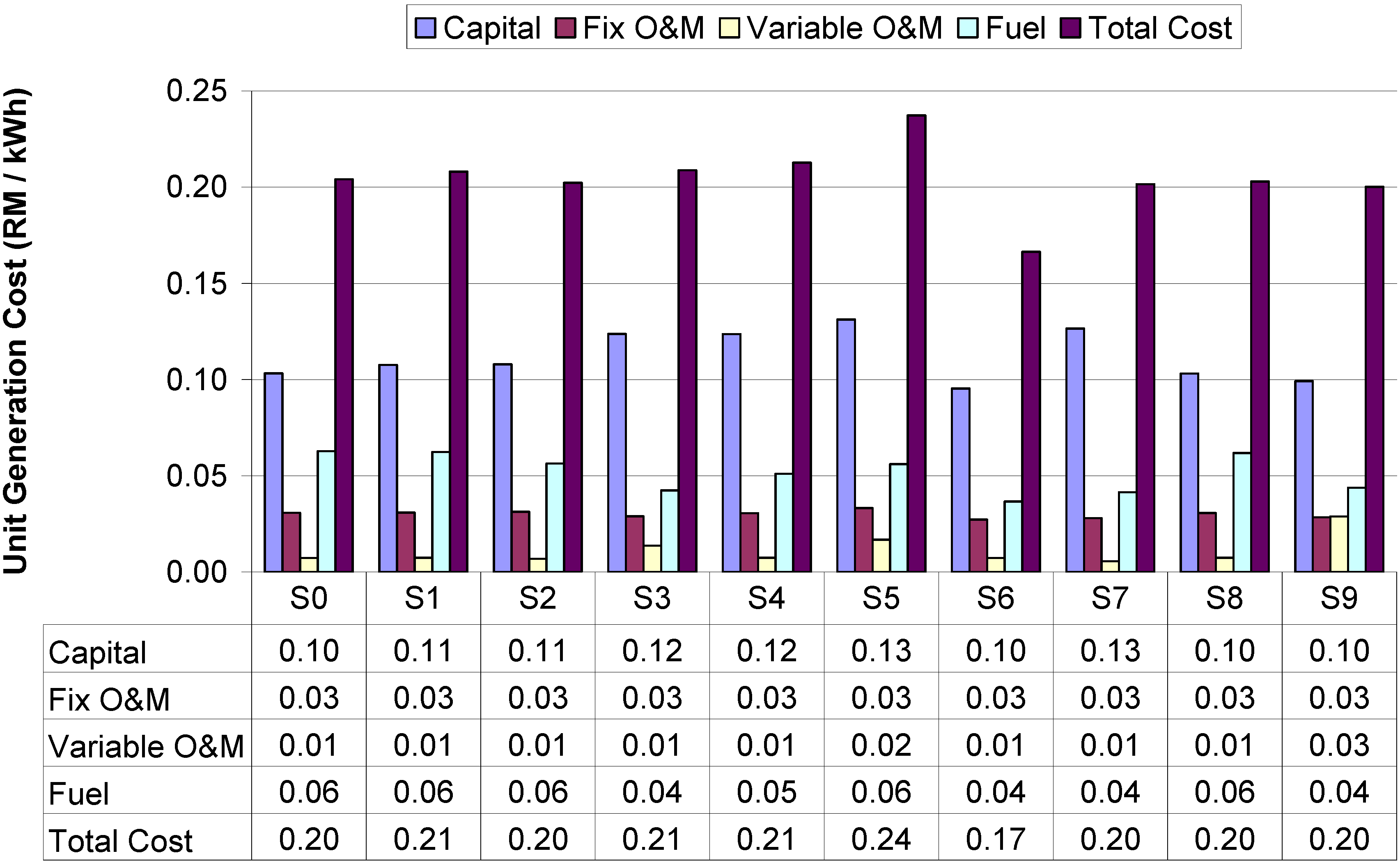

6.2. GHG Emission Reduction

6.3. Cost Effectiveness
| Scenario | [A]Emission Factor(g CO2/kWh) | [B]Unit Cost(RM/kWh) | [C] = ([B] − [B0])/([A0] − A)Cost of Emission Avoided(RM/ton CO2) |
|---|---|---|---|
| S0 | A0 = 480.2602 | B0 = 0.2042 | - |
| S1 | 478.0643 | 0.2081 | 1798.83 |
| S2 | 434.5562 | 0.2023 | −40.54 |
| S3 | 367.6682 | 0.2088 | 41.25 |
| S4 | 364.8380 | 0.2127 | 74.16 |
| S5 | 229.1243 | 0.2373 | 131.78 |
| S6 | 326.4213 | 0.1665 | −245.20 |
| S7 | 360.8535 | 0.2016 | −22.07 |
| S8 | 473.4192 | 0.2029 | −188.47 |
| S9 | 393.1160 | 0.2001 | −46.71 |
6.4. Sensitivity to Fuel Prices
| Scenario | Unit Electricity Cost with Subsidised Natural Gas (RM/kWh) [A] | Unit Electricity Cost with Unsubsidised Natural Gas(RM/kWh) [B] | [C] = ([B] − [A])/[A]*100% Percentage Price Increase |
|---|---|---|---|
| S0 | 0.20 | 0.31 | 51% |
| S1 | 0.21 | 0.31 | 50% |
| S2 | 0.20 | 0.29 | 45% |
| S3 | 0.21 | 0.28 | 34% |
| S4 | 0.21 | 0.30 | 40% |
| S5 | 0.24 | 0.32 | 36% |
| S6 | 0.17 | 0.23 | 37% |
| S7 | 0.20 | 0.27 | 35% |
| S8 | 0.20 | 0.31 | 51% |
| S9 | 0.20 | 0.27 | 37% |
7. Conclusions
Acknowledgements
References
- Richard, B. Why did Copenhagen fail to deliver a climate deal? BBC News, 22 December 2009. [Google Scholar]
- Parker, L.; Blodgett, J. Greenhouse Gas Emissions: Perspectives on the Top 20 Emitters and Developed versus Developing Nations; CRS Report for Congress; Congressional Research Service: Washington, DC, USA, 2008. [Google Scholar]
- World Resources Institute (WRI). EarthTrends: Environmental Information; WRI: Washington, DC, USA, 2010. [Google Scholar]
- International Energy Agency (IEA). World Energy Outlook 2008; IEA: Paris, France, 2008. [Google Scholar]
- Lim, Y.S.; Koh, S.L. Analytical assessments on the potential of harnessing tidal currents for electricity generation in Malaysia. Renew. Energy 2010, 35, 1024–1032. [Google Scholar] [CrossRef]
- Koh, S.L.; Lim, Y.S. Meeting energy demand in a developing economy without damaging the environment—A case study in Sabah, Malaysia, from technical, environmental and economic perspectives. Renew. Energy 2010, 38, 4719–4728. [Google Scholar]
- McCrone, A.; Usher, E.; Sonntag-O’Brien, V. Global Trends in Sustainable Energy Investment 2010 Report. In Analysis of Trends and Issues in the Financing of Renewable Energy and Energy Efficiency; United Nations Environment Programme and New Energy Finance: Geneva, Switzerland, 2010. [Google Scholar]
- Energy Commission. Interim Report on the Performance of the Electricity Supply in Malaysia for the First Half Year of 2009; Energy Commission: Putrajaya, Malaysia, 2009. [Google Scholar]
- Sopian, K.; Othman, M.Y.; Wirsat, A. The wind energy potential of Malaysia. Renew. Energy 1995, 6, 1005–1016. [Google Scholar] [CrossRef]
- Badriyah, A.M. Renewable Energy (RE) Policy & Action Plan; Sustainable Energy Division, Ministry of Energy, Green Technology and Water: Putrajaya, Malaysia, 2010. [Google Scholar]
- Commend. An Introduction to LEAP. Available online: http://www.energycommunity.org/default.asp?action=47 (accessed on 23 June 2010).
- Institute for Development Studies (IDS). Sabah Development Corridor Blueprint; Sabah Development Corridor: Sabah, Malaysia, 2007. [Google Scholar]
- Sabah Electricity Sdn Berhad (SESB). Conditions of SESB Sandakan Power Plants. Available online: http://www.sesb.com.my/news_releases_view.cfm?id=145 (accessed on 30 June 2010).
- Sorensen, B. Renewable Energy, 2nd ed.; Academic Press: Maryland Heights, MO, USA, 2000. [Google Scholar]
- Boyle, G. Renewable Energy, Power for a Sustainable Future; Oxford University Press: Oxford, UK, 2004. [Google Scholar]
- Lim, Y.S.; Lalchand, G.; Gladys, M.S.L. Economical, environmental and technical analysis of building integrated photovoltaic systems in Malaysia. Energy Policy 2008, 36, 2130–2142. [Google Scholar] [CrossRef]
- Alicia, A.A. Energy Efficiency in the APEC Region–Electricity Sector; Asia Pacific Energy Research Centre: Tokyo, Japan, 2008. [Google Scholar]
- Energy Information Administration (EIA). International Energy Outlook 2009. In Chapter 5: Electricity; EIA: Washington, DC, USA, 2009. Available online: http://www.eia.doe.gov/oiaf/ieo/electricity.html (accessed on 20 April 2011). [Google Scholar]
- Kenneth, G.; Richard, G.N.; Karen, P. Retrospective Examination of Demand-Side Energy Efficiency Policies; Resources for the Future: New York, NY, USA, 2004. [Google Scholar]
- Figueres, C.; Philips, M. Scaling up Demand–Side Energy Efficiency Improvements through Programmatic CDM. Energy Sector Management Assistance Program, the World Bank: New York, NY, USA, 2007. [Google Scholar]
- Jenkins, N.; Allan, R.; Crossley, P.; Kirschen, D.; Strbac, G. Embedded Generation. In IET Power and Energy Series, 31th ed.; Johns, A.T., Warne, D.F., Eds.; The Institution of Engineering and Technology: London, UK, 2008. [Google Scholar]
- Alnatheer, O. The potential contribution of renewable energy to electricity supply in Saudi Arabia. Energy Policy 2005, 33, 2298–2312. [Google Scholar] [CrossRef]
- Connolly, D.; Lund, H.; Mathiesen, B.V.; Leahy, M. A review of computer tools for analysing the integration of renewable energy into various energy systems. Appl. Energy 2010, 87, 1059–1082. [Google Scholar] [CrossRef]
- Stockholm Environment Institute. LEAP Application. 2010. Available online: http://www.energycommunity.org/default.asp?action=45 (accessed on 29 June 2010).
- Energy Commission. Electricity Supply Industry in Malaysia–Performance and Statistical Information; Energy Commission: Putrajaya, Malaysia, 2007. [Google Scholar]
- Tyler, M.; Daniel, M.K.; Benjamin, G. Clean energy options for Sabah—An analysis of resource availability and cost. Green SURF 2010.
- Malaysian Palm Oil Board. Overview of the Malaysian Oil Palm Industry 2009, 2009.
- Othman, M.R.; Martunus, Z.R.; Fernando, W.J.N. Strategic planning on carbon capture from coal fired plants in Malaysia and Indonesia: A review. Energy Policy 2009, 37, 1718–1735. [Google Scholar] [CrossRef]
- Akker, J.V.D. Final Evaluation—Malaysian Industrial Energy Efficiency Improvement Project (MIEEIP); UNDP: Kuala Lumpur, Malaysia, 2008. [Google Scholar]
- Faridah, M.T. Energy Efficiency, Policies, Programs and Indicators in Malaysia. In EWG 062005 Energy Efficiency Indicator Workshop-Capacity Building and Technical Cooperation in Quantifying Tangible Energy Efficiency Policy, Program and Project Progress; APEC: Moscow, Russia, 2005. [Google Scholar]
- Oh, T.H.; Chua, S.C. Energy efficiency and carbon trading potential in Malaysia. Renew. Sustain. Energy Rev. 2010, 14, 2095–2103. [Google Scholar] [CrossRef]
- Lau, L.C.; Kok, T.T.; Keat, T.L.; Abdul, R.M. A comparative study on the energy policies in Japan and Malaysia in fulfilling their nations’ obligations towards the Kyoto Protocol. Energy Policy 2009, 37, 4771–4778. [Google Scholar] [CrossRef]
- Bernama. Incandescent Lights to Be Phased out by 2014–Peter Chin. 2010. Available online: http://www.st.gov.my/index.php?Itemid=1201&catid=794:energy-news&id=5385:incandescent-lights-to-be-phased-out-by-2014-peter-chin&lang=en&optioncom_content&view=article (accessed on 7 September 2010).
- Razavi, H. Coordinated strategy for separate power systems: The case of Malaysia. Energy Econ. 1990, 12, 59–64. [Google Scholar] [CrossRef]
- Rafaj, P.; Kypreos, S. Internalisation of external cost in the power generation sector: Analysis with global multi-regional Markal model. Energy Policy 2007, 35, 828–843. [Google Scholar] [CrossRef]
- Sabah Electricity Sdn Bhd (SESB). Projek pembangunan terus dilaksana oleh SESB (Development Project to Be Implemented by SESB). 2009. Available from: http://www.sesb.com.my/news_releases_view.cfm?id=132 (accessed on 30 June 2010).
- Zuraimi, A. Hidden Costs to Subsidies. In Business Times Malaysia; New Strait Times: Kuala Lumpur, Malaysia, 2010. [Google Scholar]
- PT Coalindo Energy. Weekly Indonesia Coal Index Prices as of 23 October 2009. 2009. Available online: http://www.coalindoenergy.com/ (accessed on 20 April 2011).
- Key, T.; Peterson, T. Solar Photovoltaics: Status, Costs, and Trends; Electric Power Research Institute (EPRI): Palo Alto, CA, USA, 2009. [Google Scholar]
- Oh, T.H.; Pang, S.Y.; Chua, S.C. Energy policy and alternative energy in Malaysia: Issues and challenges for sustainable growth. Renew. Sustain. Energy Rev. 2010, 14, 1241–1252. [Google Scholar] [CrossRef]
- Construction Industry Development Board (CIDB). Building Materials Cost Index by Category of Building and Region; 2010. Available online: http://www.cidb.gov.my/v6/files/pub/CBSBJanJun10.pdf (accessed on 8 September 2010).
- Davis Langdon& Seah (DLS). Kuala Lumpur Construction Cost Trend 1998–2006. 2010. Available from: http://www.dlsqs.com/ice/index.jsp?mod=newsview&showmodonly=newsview&op=view&catid=72 (accessed on 8 September 2010).
- PHILIPS. Catalogue–Compact Fluorescent Genie 14W CDL B22. 2010. Available online: http://www.lighting.philips.com.my/v2/index.jsp (accessed on 8 September 2010).
- PHILIPS. Catalogue—SOFTONE 60W E27. 2010. Available online: http://www.lighting.philips.com.my/v2/index.jsp (accessed on 8 September 2010).
- European Climate Exchange. ICE ECX CER Daily Future Contract. 2010. Available online: http://www.ecx.eu/General/CER-price-curve-shifting-as-new-ECX-contracts-boost-transparency (accessed on 7 July 2010).
© 2011 by the authors; licensee MDPI, Basel, Switzerland. This article is an open access article distributed under the terms and conditions of the Creative Commons Attribution license (http://creativecommons.org/licenses/by/3.0/).
Share and Cite
Koh, S.L.; Lim, Y.S.; Morris, S. Cost Effective Options for Greenhouse Gas (GHG) Emission Reduction in the Power Sector for Developing Economies — A Case Study in Sabah, Malaysia. Energies 2011, 4, 780-803. https://doi.org/10.3390/en4050780
Koh SL, Lim YS, Morris S. Cost Effective Options for Greenhouse Gas (GHG) Emission Reduction in the Power Sector for Developing Economies — A Case Study in Sabah, Malaysia. Energies. 2011; 4(5):780-803. https://doi.org/10.3390/en4050780
Chicago/Turabian StyleKoh, Siong Lee, Yun Seng Lim, and Stella Morris. 2011. "Cost Effective Options for Greenhouse Gas (GHG) Emission Reduction in the Power Sector for Developing Economies — A Case Study in Sabah, Malaysia" Energies 4, no. 5: 780-803. https://doi.org/10.3390/en4050780
APA StyleKoh, S. L., Lim, Y. S., & Morris, S. (2011). Cost Effective Options for Greenhouse Gas (GHG) Emission Reduction in the Power Sector for Developing Economies — A Case Study in Sabah, Malaysia. Energies, 4(5), 780-803. https://doi.org/10.3390/en4050780




